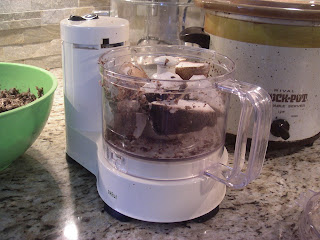Well, here it is Easter Monday, one of those strange quasi-holidays that some people have off and others don't. Banks and government offices are closed, but most stores are open. Working in the public sector as I do, I am one of the fortunate ones who have today off, so I am taking advantage of it to get my seed starting gear ready to go for another season.
It actually really does feel like spring out there today -- cloudy and rainy, but mild and the buds on the trees and shrubs are starting to plump up, the daffodils and hyacinths are shooting up tall and sturdy and the lawns are slowly starting to green up.
But, what caught my eye and made my spirits soar was this:
This miniature iris appeared out of nowhere a few years ago and has been coming up faithfully ever since. I have moved it a couple of times and I've hoped it would multiply, but so far it has been content to remain single. It's always the very first bloom to appear in my garden and when I see it I know that winter is indeed over and it's time to start getting ready for another gardening season.
The first thing I do is get all my seeds, flats, pots and planting paraphernalia out of storage and go through it all, selecting the seeds I will be planting this year (whether I'm starting them indoors or sowing them directly in the garden later when it warms up), checking the flats and pots for damage and making a shopping list for anything I might be needing for starting seed indoors.
Although I do have a 3-tier seed starting nursery with grow lights, I don't yet have the space for it in my basement, so it is currently in storage. I hope to have it installed in time for next year's planting season. So, for now, my wine-making countertop is doing double-duty as a seed nursery. I have temporarily suspended a two-bulb, 4 foot fluorescent fixture on adjustable chains above the countertop and installed grow lights in it. I will be able to lower the fixture to float just above the flats to sprout the seeds, then gradually raise it as the seedlings grow taller. For now, though I have it up close to the ceiling so I can use the counter as work space.
It's always a good idea to start each growing season clean and to that end, I like to wash all my pots, flats and clear covers. In addition, I try to save as many black cellpacks as possible. It's not that I'm cheap, but since they are not recyclable here, I like the idea of reusing them rather than throwing them in the garbage. It's not always possible to save the ones that garden center bedding plants come in since the root systems are usually so developed that it becomes nearly impossible to remove a plant from a cell without ripping it. However, with a little patience and gentle handling, sometimes you can luck out. I find the cellpacks fitted inside their flats and covered with a clear dome make an ideal seed starting environment.
When washing pots and cellpacks for re-use, it's always a good idea to add a little bleach to the wash water to help kill any bacteria and other soil-borne bugs that may have lingered over the winter.
I half-fill the laundry tub with warm water and add about a half-cup of bleach and a generous squirt of liquid laundry soap (less foamy than dish soap). When washing cellpacks, I just use my fingers to gently wash out the individual cells. I have some 6-cell packs that I bought new from a garden center last year as well as a number of 4-cell packs re-used from bedding plants I've bought over the years.
I stack the cell packs as I wash them and let them drain in one of the empty flats. Then, in the same water, I wash all my 3-inch plastic pots. I find this is a handy size to transplant seedlings into from the cellpack flats once they are large enough. I use a nylon bristle nail brush like this one from Lee Valley to scrub the pots as they are quite sturdy and then stack them in the empty flat to drain with the clean cellpacks.
I then empty the laundry tub, rinse it out and half-fill it with clear water, throw in the clean cellpacks, gently swishing them around to rinse out the soap and bleach and then leave them upside down on an old towel to drip dry. Same with the 3-inch pots.
Later, I will set up the seed flats and get my tomatoes and marigolds started. Spring has sprung!
When washing pots and cellpacks for re-use, it's always a good idea to add a little bleach to the wash water to help kill any bacteria and other soil-borne bugs that may have lingered over the winter.
I half-fill the laundry tub with warm water and add about a half-cup of bleach and a generous squirt of liquid laundry soap (less foamy than dish soap). When washing cellpacks, I just use my fingers to gently wash out the individual cells. I have some 6-cell packs that I bought new from a garden center last year as well as a number of 4-cell packs re-used from bedding plants I've bought over the years.
I stack the cell packs as I wash them and let them drain in one of the empty flats. Then, in the same water, I wash all my 3-inch plastic pots. I find this is a handy size to transplant seedlings into from the cellpack flats once they are large enough. I use a nylon bristle nail brush like this one from Lee Valley to scrub the pots as they are quite sturdy and then stack them in the empty flat to drain with the clean cellpacks.
I then empty the laundry tub, rinse it out and half-fill it with clear water, throw in the clean cellpacks, gently swishing them around to rinse out the soap and bleach and then leave them upside down on an old towel to drip dry. Same with the 3-inch pots.
Later, I will set up the seed flats and get my tomatoes and marigolds started. Spring has sprung!



















